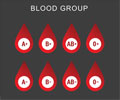People with blood group ‘A’ are more at risk for new coronavirus (COVID-19) infection, says a new study. However, people with blood type ‘O’ are at a lower risk of contracting the deadly virus.

‘People with blood group ‘A’ are more at risk for contracting the new coronavirus (COVID-19) infection and those with blood type ‘O’ are at a lower risk of contracting the deadly virus.’





Researchers led by Wang Xinghuan with the Centre for Evidence-Based and Translational Medicine at Zhongnan Hospital of Wuhan University looked at blood group patterns of more than 2,000 infected patients in Wuhan and Shenzhen.They found that blood type A patients showed a higher rate of infection and developed more severe symptoms.Of 206 patients, 85 had type A blood — 63 percent more than 52 with type O.”People of blood group A might need particularly strengthened personal protection to reduce the chance of infection,” the authors wrote, adding that Sars-CoV-2-infected patients with blood group A might need to receive more vigilant surveillance and aggressive treatment.”
Blood group O had a significantly lower risk for the infectious disease compared with non-O blood groups”, said the study that is yet to be peer reviewed.According to a study in the US National Center for Biotechnology Information (NCBI), ‘O’ is the most common blood group (37.12%) in India, closely followed by B at 32.26 percent, followed by A at 22.88 percent while AB was the least prevalent group at 7.74 percent.
In the US, about 44 percent of the population is type O, while about 41 percent is type A.Wang wrote: “It might be helpful to introduce ABO blood typing in both patients and medical personnel as a routine part of the management of Sars-CoV-2 and other coronavirus infections, to help define the management options and assess risk exposure levels of people”.
While more cases of the respiratory illness have been recorded globally, it is on the decline in China, demonstrating that the course of the outbreak there has been altered, according to WHO Representative in the country Dr Gauden Galea.
Advertisement
According to a recent study, in the case of 72,000 Chinese coronavirus patients, the overall fatality rate was 2.3 percent but in the case of adults over 80, the same rate rose to 15 percent.
Source-IANS















